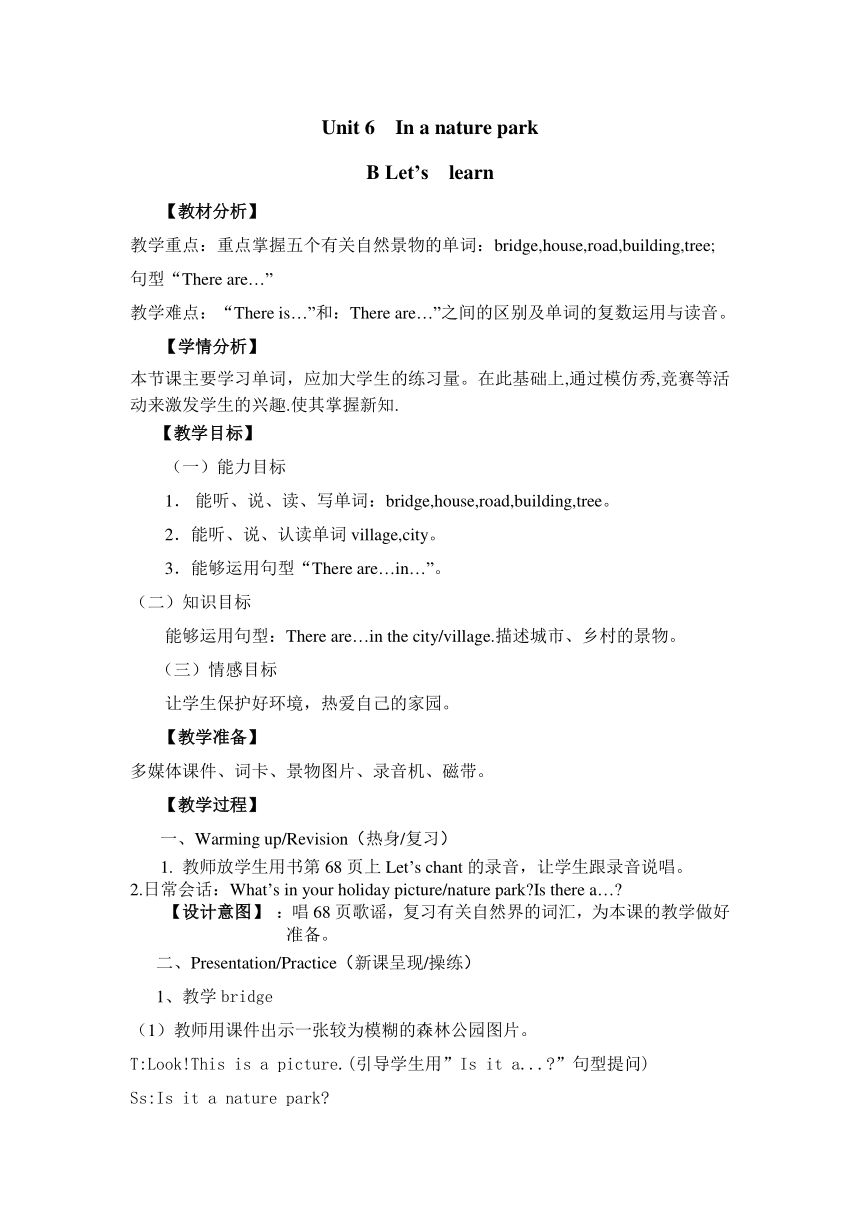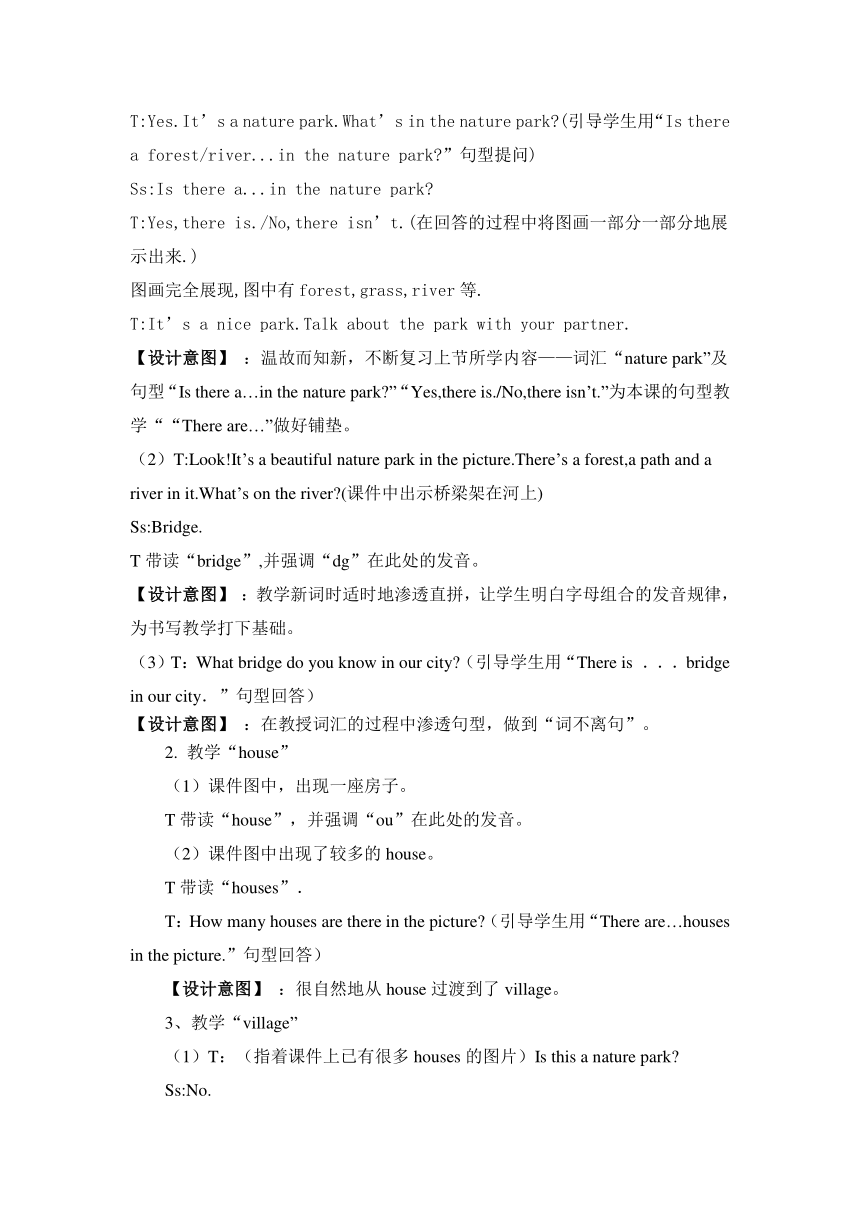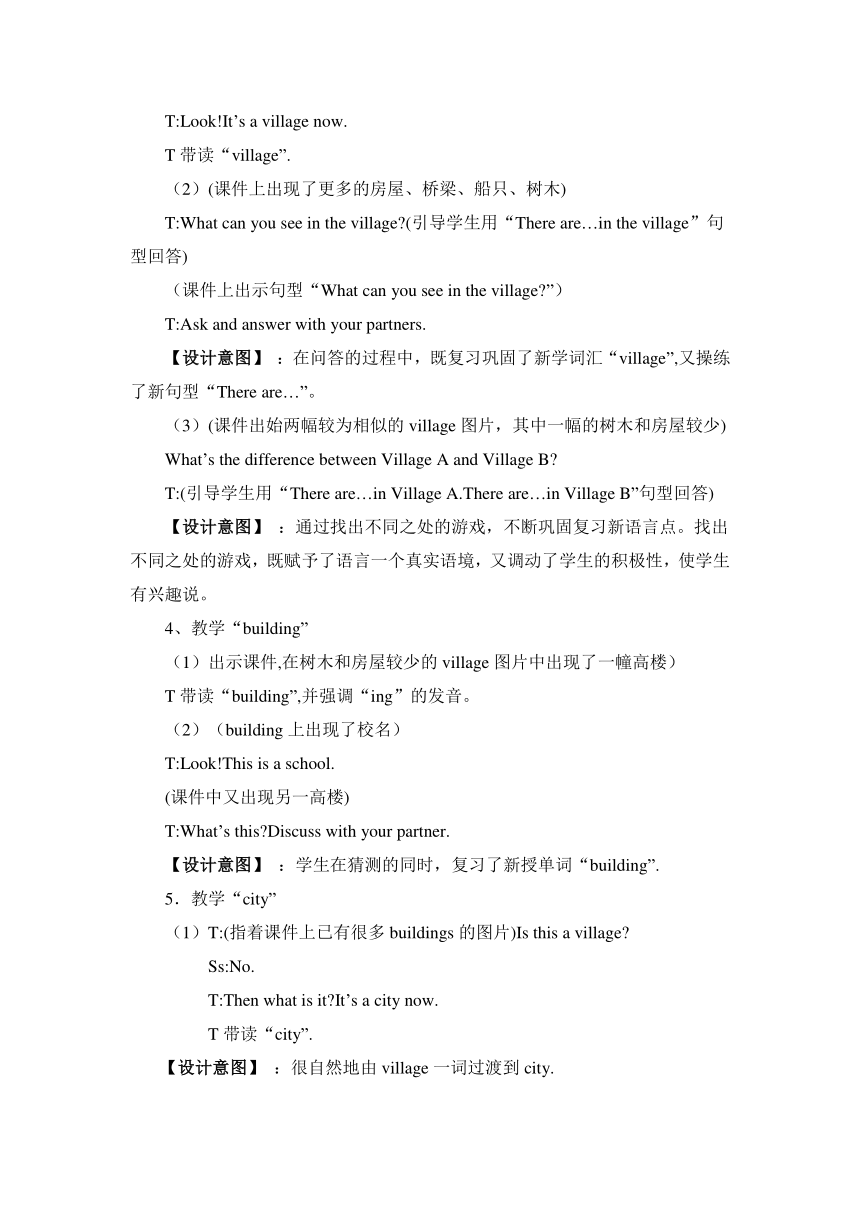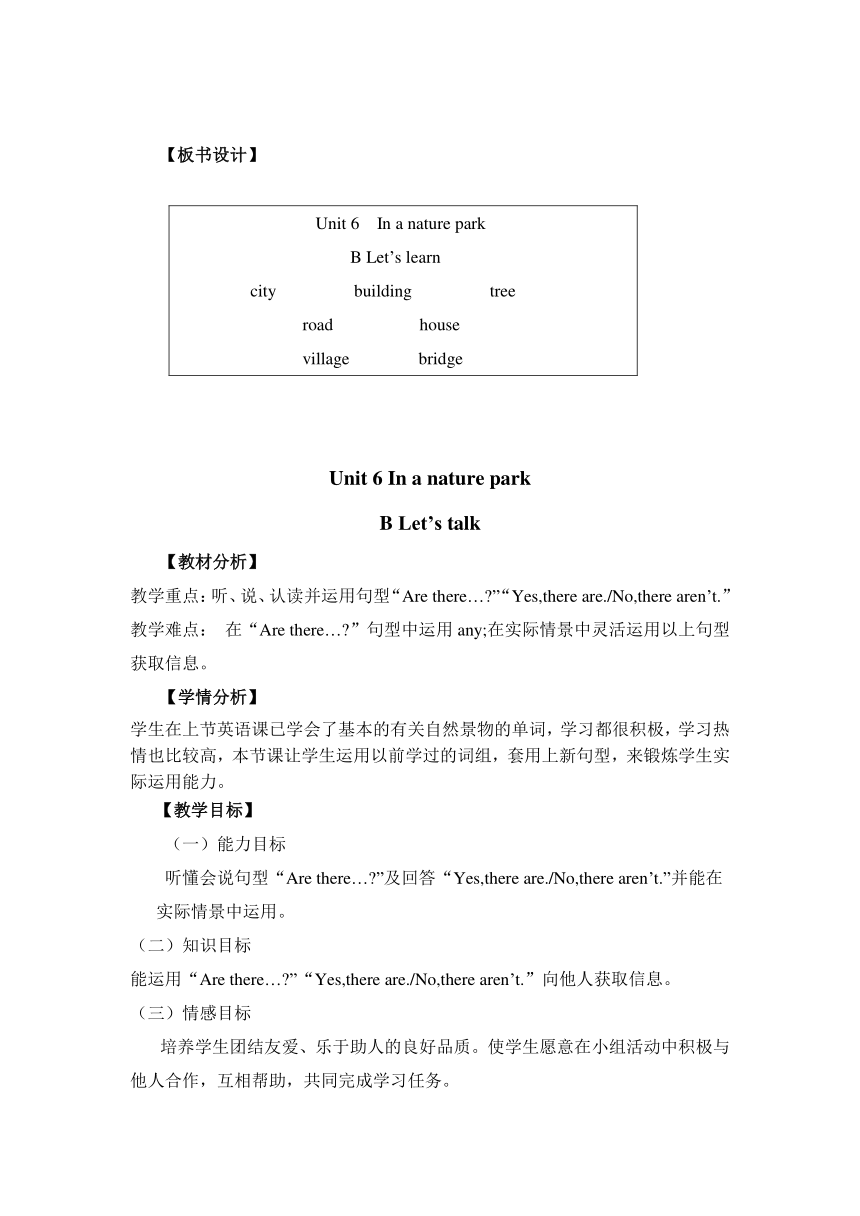人教版PEP五年级上册Unit6 In a nature park Part B 教学设计(共三课时)
文档属性
| 名称 | 人教版PEP五年级上册Unit6 In a nature park Part B 教学设计(共三课时) |  | |
| 格式 | zip | ||
| 文件大小 | 22.5KB | ||
| 资源类型 | 教案 | ||
| 版本资源 | 人教版(PEP) | ||
| 科目 | 英语 | ||
| 更新时间 | 2011-11-27 13:37:55 | ||
图片预览





文档简介
Unit 6 In a nature park
B Let’s learn
【教材分析】
教学重点:重点掌握五个有关自然景物的单词:bridge,house,road,building,tree;句型“There are…”
教学难点:“There is…”和:There are…”之间的区别及单词的复数运用与读音。
【学情分析】
本节课主要学习单词,应加大学生的练习量。在此基础上,通过模仿秀,竞赛等活动来激发学生的兴趣.使其掌握新知.
【教学目标】
(一)能力目标
1. 能听、说、读、写单词:bridge,house,road,building,tree。
2.能听、说、认读单词village,city。
3.能够运用句型“There are…in…”。
(二)知识目标
能够运用句型:There are…in the city/village.描述城市、乡村的景物。
(三)情感目标
让学生保护好环境,热爱自己的家园。
【教学准备】
多媒体课件、词卡、景物图片、录音机、磁带。
【教学过程】
一、Warming up/Revision(热身/复习)
1. 教师放学生用书第68页上Let’s chant的录音,让学生跟录音说唱。
2.日常会话:What’s in your holiday picture/nature park Is there a…
【设计意图】 :唱68页歌谣,复习有关自然界的词汇,为本课的教学做好准备。
二、Presentation/Practice(新课呈现/操练)
1、教学bridge
(1)教师用课件出示一张较为模糊的森林公园图片。
T:Look!This is a picture.(引导学生用”Is it a... ”句型提问)
Ss:Is it a nature park
T:Yes.It’s a nature park.What’s in the nature park (引导学生用“Is there a forest/river...in the nature park ”句型提问)
Ss:Is there a...in the nature park
T:Yes,there is./No,there isn’t.(在回答的过程中将图画一部分一部分地展示出来.)
图画完全展现,图中有forest,grass,river等.
T:It’s a nice park.Talk about the park with your partner.
【设计意图】 :温故而知新,不断复习上节所学内容——词汇“nature park”及句型“Is there a…in the nature park ”“Yes,there is./No,there isn’t.”为本课的句型教学““There are…”做好铺垫。
(2)T:Look!It’s a beautiful nature park in the picture.There’s a forest,a path and a river in it.What’s on the river (课件中出示桥梁架在河上)
Ss:Bridge.
T带读“bridge”,并强调“dg”在此处的发音。
【设计意图】 :教学新词时适时地渗透直拼,让学生明白字母组合的发音规律,为书写教学打下基础。
(3)T:What bridge do you know in our city (引导学生用“There is ...bridge in our city.”句型回答)
【设计意图】 :在教授词汇的过程中渗透句型,做到“词不离句”。
2. 教学“house”
(1)课件图中,出现一座房子。
T带读“house”,并强调“ou”在此处的发音。
(2)课件图中出现了较多的house。
T带读“houses”.
T:How many houses are there in the picture (引导学生用“There are…houses in the picture.”句型回答)
【设计意图】 :很自然地从house过渡到了village。
3、教学“village”
(1)T:(指着课件上已有很多houses的图片)Is this a nature park
Ss:No.
T:Look!It’s a village now.
T带读“village”.
(2)(课件上出现了更多的房屋、桥梁、船只、树木)
T:What can you see in the village (引导学生用“There are…in the village”句型回答)
(课件上出示句型“What can you see in the village ”)
T:Ask and answer with your partners.
【设计意图】 :在问答的过程中,既复习巩固了新学词汇“village”,又操练了新句型“There are…”。
(3)(课件出始两幅较为相似的village图片,其中一幅的树木和房屋较少)
What’s the difference between Village A and Village B
T:(引导学生用“There are…in Village A.There are…in Village B”句型回答)
【设计意图】 :通过找出不同之处的游戏,不断巩固复习新语言点。找出不同之处的游戏,既赋予了语言一个真实语境,又调动了学生的积极性,使学生有兴趣说。
4、教学“building”
(1)出示课件,在树木和房屋较少的village图片中出现了一幢高楼)
T带读“building”,并强调“ing”的发音。
(2)(building上出现了校名)
T:Look!This is a school.
(课件中又出现另一高楼)
T:What’s this Discuss with your partner.
【设计意图】 :学生在猜测的同时,复习了新授单词“building”.
5.教学“city”
(1)T:(指着课件上已有很多buildings的图片)Is this a village
Ss:No.
T:Then what is it It’s a city now.
T带读“city”.
【设计意图】 :很自然地由village一词过渡到city.
(2)T:(教师画简笔画)Guess.Is this a village or a city
Ss:It’s a village/city.There are/There is a…in the village/city.
【设计意图】 :猜一猜“village or city”这一游戏,巩固复习了本课所学词汇与句型。也为下一个环节做了铺垫。
(3)呈现图片Let’s start(P68)
What’s the difference between Picture A and Picture B
6.教学“road”
(1)(教师画出一条江河样的图形,在上面添上几艘船)
Ss:It’s a river.There are some boats in the river.
T带读“boat”,引导学生发现“oa”的发音。
(教师又画出一条江河样的图形,在上面添上几辆汽车)
(教师板书road一词)
Ss:road.
【设计意图】 :通过已学词汇boat得出字母组合“oa”在单词中的发音,为下面road一词的教学做了铺垫。
三、Consolidation and extension(巩固与拓展)
1、城乡区别用“There are/There is…in the village/city.”句型与同伴讨论,说一说城乡之间的区别。
2、画出你所向往的居住地,并向同伴做一介绍。
3、Sum up(总结)
Look!This is my village.There are many small houses,paths,big trees and many bridges in my village,I love my village very much.把单词组合成句子,再把句子组合成小短文,对学生进行语篇教学,为学生写作文做铺垫。
4、Good to know:教师介绍熊猫的生活习性,教育学生要保护熊猫,保护自然环境。
四、Homework(作业)
用There are/is…in my village.句型来介绍自己的家乡.
【板书设计】
Unit 6 In a nature parkB Let’s learncity building treeroad house village bridge
Unit 6 In a nature park
B Let’s talk
【教材分析】
教学重点:听、说、认读并运用句型“Are there… ”“Yes,there are./No,there aren’t.”
教学难点: 在“Are there… ”句型中运用any;在实际情景中灵活运用以上句型获取信息。
【学情分析】
学生在上节英语课已学会了基本的有关自然景物的单词,学习都很积极,学习热情也比较高,本节课让学生运用以前学过的词组,套用上新句型,来锻炼学生实际运用能力。
【教学目标】
(一)能力目标
听懂会说句型“Are there… ”及回答“Yes,there are./No,there aren’t.”并能在实际情景中运用。
(二)知识目标
能运用“Are there… ”“Yes,there are./No,there aren’t.”向他人获取信息。
(三)情感目标
培养学生团结友爱、乐于助人的良好品质。使学生愿意在小组活动中积极与他人合作,互相帮助,共同完成学习任务。
【教学准备】
多媒体课件、图片、简笔画、盒子、蜡笔、纸张、录音机、磁带。
【教学过程】
一、Warming up/Revision(热身/复习)
1. Let’s sing:My bedroom(P66)
2.Let’s chant(P68)
【设计意图】 :唱歌曲,复习“There is…”句型;唱歌谣,复习有关自然界的词汇,为本课的教学做好准备。.
二、Presentation/Practice(新课呈现/操练)
1、教学句型“Yes,there are.”“No,there aren’t.”
(1)课件出示城市图片
T:It’s a city.Do you like the city Why Talk about this city.
(引导学生用“There is/There are...in the city ”句型讨论)
【设计意图】 :复习上节课所学句型“There is a/There are…in the…”
(2)课件出示一张乡村图片
T:Is this a city
Ss:No,it’s a village.
T:Are there any tall buildings in the village
Ss:No.(教师引导学生用“No,there aren’t.”回答)
T:Are there any green trees in the village
Ss:Yes.(教师引导学生回答)
T带读“No,there aren’t.”“Yes,there are.”
【设计意图】 :自然导入到句型教学。
(3)课件出示不同的四幅乡村、城市图片。
T:Which place do you want to live in Why
Ss:I want to live in City A.Because there are many tall buildings/…
【设计意图】 :说说自己所喜爱的居住地,用语言表达思想、情感。并为下一个教学环节做了铺垫。
(4)T(toS1):Do you want to live in the city or in the village
Ss:In the city./In the village.
T:Are there any tall buildings in the village/city
Ss:Yes,there are./No,there aren’t.
T:Are there any beautiful flowers in the village/city
Ss:Yes,there are./No,there aren’t.
T:Do you want to live in Village A
Ss:Yes./No.
【设计意图】 :从表达自己所喜爱的居住地,自然过渡到教师猜学生所喜爱的居住地。适时操练了新授句型“No,there aren’t.”“Yes,there are.”
2. 教学“Are there any…in the… ”
(1)教师提问几个学生后出示句型“Are there any…in the… ”
T带读句子。
【设计意图】 :在教学中不断有意识渗透,减少了新授句型的难度。
(2)T:与你的同伴做问答练习。猜猜你的同伴想住在哪里?
Ss与同伴操练。
【设计意图】 :前面教学环节中的教师示范便于学生此时的活动开展。
(3)T(出示一个盒子,摇晃盒子,发出声响)
T:Look!I have a box.What’s in the box (引导学生用“Are there any…in the box ”句型提问)
T:(打开盒子,盒子中有许多蜡笔)There are many crayons in the box.I can use the crayons to draw any place you want to go.
【设计意图】 :学生有兴趣猜测盒子里的东西,在猜测的过程中达到语言操练的目的。
(4)T(toS2):Where do you want to go
S2:I want to go to a nature park.
T(画出公园轮廓):Are there any beautiful flowers in the park
S2:Yes,there are.
T(画出一些花朵):Are there any tall buildings in the park
S2:No,there aren’t.
…
【设计意图】 :在画图活动中操练语言。
(5)T:Now,who can draw a picture
S3(to T):Where do you want to go
T:I want to go to a bedroom.
S3:Are there any red sofas in the bedroom
T:Yes,there are.
…
【设计意图】 :加大活动的难度,并为下面活动的开展做了较为到位的示范。体现了“由扶到放”的过程。
三、Consolidation and extension(巩固与拓展)
1、最佳拍挡
同伴之间通过用句型“Are there any…in your… ”“Yes,there are./No,there aren’t.”的问答来画出对方想要去的地方。
2、Let’s talk
(1)教师提问Are there any tall buildings in the village
(2)学生听录音,找出答案。
(3)学生翻开书,听录音,跟读。
【设计意图】 :通过提问题,让学生带着问题,有针对性地听录音,训练学生的听力,由听过渡到说,符合学生认知水平。
3、找出小画家
教师将不同学生画的图片贴在黑板上,学生提问“Are there any…in the picture ”,小画家们用“Yes,there are./Yes,there is./No,there aren’t./No,there isn’t.”回答。学生通过小画家的回答,找出相对应的小画家与作品。
【设计意图】 :创设语境,运用语言,并使学生在运用语言时有了任务驱动。
四、Homework(作业)
让学生用“Are there any…in your… ”句型来互相询问,并做好记录,最后做一个总结。
【板书设计】
Unit 6 In a nature parkB Let’s talkAre there any bridges in your village Yes,there are.Are there any tall buildings in your village No,there aren’t.
Unit 6 In a nature park
B Read and write
【教材分析】
教学重点:需要重点掌握句型:Are there any…in the… 的书写。
教学难点:单词fish的复数与其单数形式相同,教师要适当引导学生正确使用。
【学情分析】
学生们学习阅读理解课难度较大,应增加他们语言听的输入量和说的输出量。可以采取辩论赛的形式,增加孩子的竞争意识与团体协作能力。
【教学目标】
(一)能力目标
能够听、说、读、写本课句型:Are there any…in the… Yes,there are.No,there aren’t.及单词:mountain.
(二)知识目标
能用“There be…”句型(陈述句、一般疑问句等形式)介绍山村并描述其特征。
(三)情感目标
让学生会用英语介绍自己的家乡,并且要热爱自己的家乡。
【教学准备】
多媒体课件、图片、词卡、挂图、录音机、磁带。
【教学过程】
一、Warming up/Revision(热身/复习)
1. Let’s chant together(the chant on P68)
【设计意图】 :课前进行chant的导入,活跃课堂气氛。
2.a guessing game:
(1)(animals)
T:Is there a monkey in the tree
S:Yes,there is.
T:Are there any fish in the sky
S:o,there aren’t.
T:Are there any dogs in the classroom
S:No,there aren’t.
(2)(home)
T:Is there a sofa in the living room
Is there a bed in the bedroom
Are there any books in the kitchen
Are there any chairs on the table
【设计意图】 :本环节,通过回答yes和no来复习there be句型的听和说,既能增加语言听的输入量和说的输出量,复习旧知,又能为下一步教学做好铺垫。
二、Presentation/Practice(新课呈现/操练)
1、Let students read the dialogue on the page 75 of SB.
Then finish the questions.
2. T can offer some questions for them to discuss.
Why does Sarah like village
Why does Chen Jie like village too
3、T organizes a press conference two of the students be Sarah and Chen Jie.They are answering the questions from the journalists.
(We can also offer different topics for the interview,such as Future Garden,Disniyland,our new school…)
【设计意图】 :记者招待会的形式可以让语言在真实的情境中得以运用。同时又可以结合自身生活经历,拓宽生活常识。
三、Consolidation and extension(巩固与拓展)
1、Task:A debate
(1)Read the following two passages
------“I love the city!There are tall buildings,movie theaters,and supermarkets.There are museums,parks.There are restaurants.You can see many different cars and many different kinds of people.”
------“I love the village!There are birds,trees,rivers,flowers and grass.There are different kinds of animals.You can run and play in the fields.You can fish and swim in the lakes or rivers.”
(2)Devide the class into two parts.One is for the city,and the other one is for the village.Let them have a debate and write the keys on the blackboard.
【设计意图】 :增加孩子阅读量,也是为了输出做铺垫。同时采取辩论赛的形式,可以增加孩子的竞争意识与团体协作的能力培养。
2、Task time:
(1)Make a tourism advertisement for a nature park or a mountain village following the task time on page 76.
(2)Talk about your ad and find out who like it.
【设计意图】 :广告招贴能很好地体现孩子的综合分析、处理、重组信息的能力,同时以小组合作的方式,更促进了交流和发展。
四、Homework(作业)
让学生用英语写一篇短文,介绍自己的居住地,乡村或城市,要运用本课所学的句型。
【板书设计】
Unit 6 In a nature parkB Read and writeAre there any pandas in the mountains No,there aren’t.Are there any fish in the rivers Yes,there are.
B Let’s learn
【教材分析】
教学重点:重点掌握五个有关自然景物的单词:bridge,house,road,building,tree;句型“There are…”
教学难点:“There is…”和:There are…”之间的区别及单词的复数运用与读音。
【学情分析】
本节课主要学习单词,应加大学生的练习量。在此基础上,通过模仿秀,竞赛等活动来激发学生的兴趣.使其掌握新知.
【教学目标】
(一)能力目标
1. 能听、说、读、写单词:bridge,house,road,building,tree。
2.能听、说、认读单词village,city。
3.能够运用句型“There are…in…”。
(二)知识目标
能够运用句型:There are…in the city/village.描述城市、乡村的景物。
(三)情感目标
让学生保护好环境,热爱自己的家园。
【教学准备】
多媒体课件、词卡、景物图片、录音机、磁带。
【教学过程】
一、Warming up/Revision(热身/复习)
1. 教师放学生用书第68页上Let’s chant的录音,让学生跟录音说唱。
2.日常会话:What’s in your holiday picture/nature park Is there a…
【设计意图】 :唱68页歌谣,复习有关自然界的词汇,为本课的教学做好准备。
二、Presentation/Practice(新课呈现/操练)
1、教学bridge
(1)教师用课件出示一张较为模糊的森林公园图片。
T:Look!This is a picture.(引导学生用”Is it a... ”句型提问)
Ss:Is it a nature park
T:Yes.It’s a nature park.What’s in the nature park (引导学生用“Is there a forest/river...in the nature park ”句型提问)
Ss:Is there a...in the nature park
T:Yes,there is./No,there isn’t.(在回答的过程中将图画一部分一部分地展示出来.)
图画完全展现,图中有forest,grass,river等.
T:It’s a nice park.Talk about the park with your partner.
【设计意图】 :温故而知新,不断复习上节所学内容——词汇“nature park”及句型“Is there a…in the nature park ”“Yes,there is./No,there isn’t.”为本课的句型教学““There are…”做好铺垫。
(2)T:Look!It’s a beautiful nature park in the picture.There’s a forest,a path and a river in it.What’s on the river (课件中出示桥梁架在河上)
Ss:Bridge.
T带读“bridge”,并强调“dg”在此处的发音。
【设计意图】 :教学新词时适时地渗透直拼,让学生明白字母组合的发音规律,为书写教学打下基础。
(3)T:What bridge do you know in our city (引导学生用“There is ...bridge in our city.”句型回答)
【设计意图】 :在教授词汇的过程中渗透句型,做到“词不离句”。
2. 教学“house”
(1)课件图中,出现一座房子。
T带读“house”,并强调“ou”在此处的发音。
(2)课件图中出现了较多的house。
T带读“houses”.
T:How many houses are there in the picture (引导学生用“There are…houses in the picture.”句型回答)
【设计意图】 :很自然地从house过渡到了village。
3、教学“village”
(1)T:(指着课件上已有很多houses的图片)Is this a nature park
Ss:No.
T:Look!It’s a village now.
T带读“village”.
(2)(课件上出现了更多的房屋、桥梁、船只、树木)
T:What can you see in the village (引导学生用“There are…in the village”句型回答)
(课件上出示句型“What can you see in the village ”)
T:Ask and answer with your partners.
【设计意图】 :在问答的过程中,既复习巩固了新学词汇“village”,又操练了新句型“There are…”。
(3)(课件出始两幅较为相似的village图片,其中一幅的树木和房屋较少)
What’s the difference between Village A and Village B
T:(引导学生用“There are…in Village A.There are…in Village B”句型回答)
【设计意图】 :通过找出不同之处的游戏,不断巩固复习新语言点。找出不同之处的游戏,既赋予了语言一个真实语境,又调动了学生的积极性,使学生有兴趣说。
4、教学“building”
(1)出示课件,在树木和房屋较少的village图片中出现了一幢高楼)
T带读“building”,并强调“ing”的发音。
(2)(building上出现了校名)
T:Look!This is a school.
(课件中又出现另一高楼)
T:What’s this Discuss with your partner.
【设计意图】 :学生在猜测的同时,复习了新授单词“building”.
5.教学“city”
(1)T:(指着课件上已有很多buildings的图片)Is this a village
Ss:No.
T:Then what is it It’s a city now.
T带读“city”.
【设计意图】 :很自然地由village一词过渡到city.
(2)T:(教师画简笔画)Guess.Is this a village or a city
Ss:It’s a village/city.There are/There is a…in the village/city.
【设计意图】 :猜一猜“village or city”这一游戏,巩固复习了本课所学词汇与句型。也为下一个环节做了铺垫。
(3)呈现图片Let’s start(P68)
What’s the difference between Picture A and Picture B
6.教学“road”
(1)(教师画出一条江河样的图形,在上面添上几艘船)
Ss:It’s a river.There are some boats in the river.
T带读“boat”,引导学生发现“oa”的发音。
(教师又画出一条江河样的图形,在上面添上几辆汽车)
(教师板书road一词)
Ss:road.
【设计意图】 :通过已学词汇boat得出字母组合“oa”在单词中的发音,为下面road一词的教学做了铺垫。
三、Consolidation and extension(巩固与拓展)
1、城乡区别用“There are/There is…in the village/city.”句型与同伴讨论,说一说城乡之间的区别。
2、画出你所向往的居住地,并向同伴做一介绍。
3、Sum up(总结)
Look!This is my village.There are many small houses,paths,big trees and many bridges in my village,I love my village very much.把单词组合成句子,再把句子组合成小短文,对学生进行语篇教学,为学生写作文做铺垫。
4、Good to know:教师介绍熊猫的生活习性,教育学生要保护熊猫,保护自然环境。
四、Homework(作业)
用There are/is…in my village.句型来介绍自己的家乡.
【板书设计】
Unit 6 In a nature parkB Let’s learncity building treeroad house village bridge
Unit 6 In a nature park
B Let’s talk
【教材分析】
教学重点:听、说、认读并运用句型“Are there… ”“Yes,there are./No,there aren’t.”
教学难点: 在“Are there… ”句型中运用any;在实际情景中灵活运用以上句型获取信息。
【学情分析】
学生在上节英语课已学会了基本的有关自然景物的单词,学习都很积极,学习热情也比较高,本节课让学生运用以前学过的词组,套用上新句型,来锻炼学生实际运用能力。
【教学目标】
(一)能力目标
听懂会说句型“Are there… ”及回答“Yes,there are./No,there aren’t.”并能在实际情景中运用。
(二)知识目标
能运用“Are there… ”“Yes,there are./No,there aren’t.”向他人获取信息。
(三)情感目标
培养学生团结友爱、乐于助人的良好品质。使学生愿意在小组活动中积极与他人合作,互相帮助,共同完成学习任务。
【教学准备】
多媒体课件、图片、简笔画、盒子、蜡笔、纸张、录音机、磁带。
【教学过程】
一、Warming up/Revision(热身/复习)
1. Let’s sing:My bedroom(P66)
2.Let’s chant(P68)
【设计意图】 :唱歌曲,复习“There is…”句型;唱歌谣,复习有关自然界的词汇,为本课的教学做好准备。.
二、Presentation/Practice(新课呈现/操练)
1、教学句型“Yes,there are.”“No,there aren’t.”
(1)课件出示城市图片
T:It’s a city.Do you like the city Why Talk about this city.
(引导学生用“There is/There are...in the city ”句型讨论)
【设计意图】 :复习上节课所学句型“There is a/There are…in the…”
(2)课件出示一张乡村图片
T:Is this a city
Ss:No,it’s a village.
T:Are there any tall buildings in the village
Ss:No.(教师引导学生用“No,there aren’t.”回答)
T:Are there any green trees in the village
Ss:Yes.(教师引导学生回答)
T带读“No,there aren’t.”“Yes,there are.”
【设计意图】 :自然导入到句型教学。
(3)课件出示不同的四幅乡村、城市图片。
T:Which place do you want to live in Why
Ss:I want to live in City A.Because there are many tall buildings/…
【设计意图】 :说说自己所喜爱的居住地,用语言表达思想、情感。并为下一个教学环节做了铺垫。
(4)T(toS1):Do you want to live in the city or in the village
Ss:In the city./In the village.
T:Are there any tall buildings in the village/city
Ss:Yes,there are./No,there aren’t.
T:Are there any beautiful flowers in the village/city
Ss:Yes,there are./No,there aren’t.
T:Do you want to live in Village A
Ss:Yes./No.
【设计意图】 :从表达自己所喜爱的居住地,自然过渡到教师猜学生所喜爱的居住地。适时操练了新授句型“No,there aren’t.”“Yes,there are.”
2. 教学“Are there any…in the… ”
(1)教师提问几个学生后出示句型“Are there any…in the… ”
T带读句子。
【设计意图】 :在教学中不断有意识渗透,减少了新授句型的难度。
(2)T:与你的同伴做问答练习。猜猜你的同伴想住在哪里?
Ss与同伴操练。
【设计意图】 :前面教学环节中的教师示范便于学生此时的活动开展。
(3)T(出示一个盒子,摇晃盒子,发出声响)
T:Look!I have a box.What’s in the box (引导学生用“Are there any…in the box ”句型提问)
T:(打开盒子,盒子中有许多蜡笔)There are many crayons in the box.I can use the crayons to draw any place you want to go.
【设计意图】 :学生有兴趣猜测盒子里的东西,在猜测的过程中达到语言操练的目的。
(4)T(toS2):Where do you want to go
S2:I want to go to a nature park.
T(画出公园轮廓):Are there any beautiful flowers in the park
S2:Yes,there are.
T(画出一些花朵):Are there any tall buildings in the park
S2:No,there aren’t.
…
【设计意图】 :在画图活动中操练语言。
(5)T:Now,who can draw a picture
S3(to T):Where do you want to go
T:I want to go to a bedroom.
S3:Are there any red sofas in the bedroom
T:Yes,there are.
…
【设计意图】 :加大活动的难度,并为下面活动的开展做了较为到位的示范。体现了“由扶到放”的过程。
三、Consolidation and extension(巩固与拓展)
1、最佳拍挡
同伴之间通过用句型“Are there any…in your… ”“Yes,there are./No,there aren’t.”的问答来画出对方想要去的地方。
2、Let’s talk
(1)教师提问Are there any tall buildings in the village
(2)学生听录音,找出答案。
(3)学生翻开书,听录音,跟读。
【设计意图】 :通过提问题,让学生带着问题,有针对性地听录音,训练学生的听力,由听过渡到说,符合学生认知水平。
3、找出小画家
教师将不同学生画的图片贴在黑板上,学生提问“Are there any…in the picture ”,小画家们用“Yes,there are./Yes,there is./No,there aren’t./No,there isn’t.”回答。学生通过小画家的回答,找出相对应的小画家与作品。
【设计意图】 :创设语境,运用语言,并使学生在运用语言时有了任务驱动。
四、Homework(作业)
让学生用“Are there any…in your… ”句型来互相询问,并做好记录,最后做一个总结。
【板书设计】
Unit 6 In a nature parkB Let’s talkAre there any bridges in your village Yes,there are.Are there any tall buildings in your village No,there aren’t.
Unit 6 In a nature park
B Read and write
【教材分析】
教学重点:需要重点掌握句型:Are there any…in the… 的书写。
教学难点:单词fish的复数与其单数形式相同,教师要适当引导学生正确使用。
【学情分析】
学生们学习阅读理解课难度较大,应增加他们语言听的输入量和说的输出量。可以采取辩论赛的形式,增加孩子的竞争意识与团体协作能力。
【教学目标】
(一)能力目标
能够听、说、读、写本课句型:Are there any…in the… Yes,there are.No,there aren’t.及单词:mountain.
(二)知识目标
能用“There be…”句型(陈述句、一般疑问句等形式)介绍山村并描述其特征。
(三)情感目标
让学生会用英语介绍自己的家乡,并且要热爱自己的家乡。
【教学准备】
多媒体课件、图片、词卡、挂图、录音机、磁带。
【教学过程】
一、Warming up/Revision(热身/复习)
1. Let’s chant together(the chant on P68)
【设计意图】 :课前进行chant的导入,活跃课堂气氛。
2.a guessing game:
(1)(animals)
T:Is there a monkey in the tree
S:Yes,there is.
T:Are there any fish in the sky
S:o,there aren’t.
T:Are there any dogs in the classroom
S:No,there aren’t.
(2)(home)
T:Is there a sofa in the living room
Is there a bed in the bedroom
Are there any books in the kitchen
Are there any chairs on the table
【设计意图】 :本环节,通过回答yes和no来复习there be句型的听和说,既能增加语言听的输入量和说的输出量,复习旧知,又能为下一步教学做好铺垫。
二、Presentation/Practice(新课呈现/操练)
1、Let students read the dialogue on the page 75 of SB.
Then finish the questions.
2. T can offer some questions for them to discuss.
Why does Sarah like village
Why does Chen Jie like village too
3、T organizes a press conference two of the students be Sarah and Chen Jie.They are answering the questions from the journalists.
(We can also offer different topics for the interview,such as Future Garden,Disniyland,our new school…)
【设计意图】 :记者招待会的形式可以让语言在真实的情境中得以运用。同时又可以结合自身生活经历,拓宽生活常识。
三、Consolidation and extension(巩固与拓展)
1、Task:A debate
(1)Read the following two passages
------“I love the city!There are tall buildings,movie theaters,and supermarkets.There are museums,parks.There are restaurants.You can see many different cars and many different kinds of people.”
------“I love the village!There are birds,trees,rivers,flowers and grass.There are different kinds of animals.You can run and play in the fields.You can fish and swim in the lakes or rivers.”
(2)Devide the class into two parts.One is for the city,and the other one is for the village.Let them have a debate and write the keys on the blackboard.
【设计意图】 :增加孩子阅读量,也是为了输出做铺垫。同时采取辩论赛的形式,可以增加孩子的竞争意识与团体协作的能力培养。
2、Task time:
(1)Make a tourism advertisement for a nature park or a mountain village following the task time on page 76.
(2)Talk about your ad and find out who like it.
【设计意图】 :广告招贴能很好地体现孩子的综合分析、处理、重组信息的能力,同时以小组合作的方式,更促进了交流和发展。
四、Homework(作业)
让学生用英语写一篇短文,介绍自己的居住地,乡村或城市,要运用本课所学的句型。
【板书设计】
Unit 6 In a nature parkB Read and writeAre there any pandas in the mountains No,there aren’t.Are there any fish in the rivers Yes,there are.
